Here’s How to Use Blocks in 10 Common Poses (With Modifications to Ease or Deepen Each Posture)
If you practice yoga and haven’t made yoga blocks your best friend, now is the time. But not everyone feels comfortable using blocks or even knows how to use yoga blocks at all.
Many practitioners may feel inferior using props to assist postures, but props like yoga blocks can make postures not only more accessible, but can also deepen postures for more advanced practitioners.
Let’s explore how to use yoga blocks in 10 common postures where the use of blocks allows each shape to become more accessible and can also deepen the postures, too.
How to Use Yoga Blocks – Here Are 10 Common Poses You Can Modify With Blocks:
In the following postures, make sure you use an appropriate height of the block. There is a “small,” “medium,” and “large” edge of the block. Be sure your yoga blocks are always stable when practicing postures.
Choose the correct type of block for you, too. More weight-bearing positions require stable cork blocks. However, these rigid blocks should not be used on joints. Foam blocks are less stable but more comforting to joints. It’s a good idea to have both types available as your practice grows.
1. Balasana (Child’s Pose)
Child’s Pose is known as a restorative posture and can be quite restful. But because of the weight and position of the head, this posture can be very uncomfortable and prove difficult for many.
How to Use Yoga Blocks in Balasana:
For more accessibility:
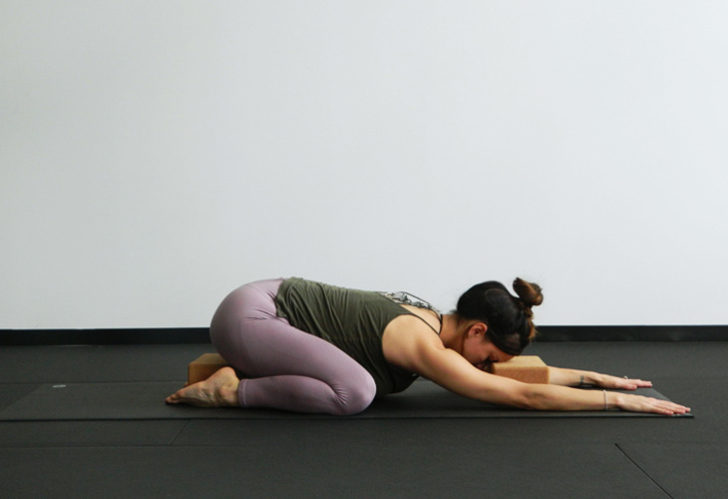
- Place the block under your forehead (or at your third eye center – the space between the eyebrows – and massage your brow bone)
- Place another block under your tailbone
To deepen the posture:

- Place your forearms or elbows on two yoga blocks for an arm and chest stretch
2. Adho Mukha Svanasana (Downward Facing Dog)
Downward Facing Dog has many benefits. However, this pose can be challenging as it requires a lot of upper body strength and the need to hang the head below the heart.
How to Use Yoga Blocks in Adho Mukha Svanasana:
For more accessibility:

- Use the blocks underneath your palms to shift your weight back toward your heels to alleviate pressure in your wrists
To deepen the posture:

- Place the blocks under your feet
- Or place the blocks against a wall and then place your feet on them
3. Uttanasana (Standing Forward Fold)
Standing Forward Fold stretches the entire back side of the legs and can be calming to the heart and mind. But it can also be challenging for those with limitations.
How to Use Yoga Blocks in Uttanasana:
For more accessibility:

- Place your fingertips (without a lot of weight in your hands) on any appropriate height of the block. Bend your knees as much as you’d like here
To deepen the posture:

- Place one foot on each block. If your foot is too large for one block, you may need to turn the block diagonal or align two blocks to make it longer
4. Setu Bandhasana (Bridge Pose)
Bridge Pose is used to strengthen the backside of the body and to open the front side. It can also be a restorative posture with the use of yoga blocks.
How to Use Yoga Blocks in Setu Bandhasana:
For more accessibility:

- With the soles of your feet on the mat, place any appropriate height of your block underneath your sacrum and rest your weight onto the block
To deepen the posture:
- Bridge Deep
- Bridge Deep2 1
- With the block under your sacrum, perhaps adjust the block’s height and then slowly straighten one leg at a time. You can bring one knee into your chest, deepening the posture even more
- Place a block in between your thighs in a standard Bridge Pose, engaging the legs to hold the block in place and then try hip raises with the block here
Want to use more than just yoga blocks in your practice? Here’s How to Use 3 Common Yoga Props In Your Practice (Video Tutorial)
5. Anjaneyasana (Crescent Lunge)
It’s true: “Issues live in our tissues.” Crescent Lunge will help you release these issues by focusing on the hip flexors. If you do a lot of sitting, try implementing Crescent Lunge or Low Lunge into your daily practice, even if it’s the only posture you do each day.
How to Use Yoga Blocks in Anjaneyasana:
For more accessibility:

- Use a block underneath each hand to support your torso with both legs lifted and strong
- Place a foam block underneath your back knee as you release your back knee toward the floor
To deepen the posture:
- Place a block underneath your front foot in Crescent Lunge or Low Lunge
6. Supta Virasana (Reclined Hero’s Pose)
If you have knee issues, you may want to place an extra cushion such as a blanket underneath them.
How to Use Yoga Blocks in Supta Virasana:
For more accessibility:

- Place a block underneath your tailbone
- In addition to sitting on a block, use two blocks underneath your hands, forearms, or elbows when reclining to your comfort level
To deepen the posture:

- Clasp a block at its widest position with both hands. Keeping both shoulder blades on the earth, press into the block and slowly move the block above your head to bring your biceps by your ears. Repeat for eight to 10 slow and controlled breaths
- Place a block at a taller height between your shoulder blades, creating a heart opener. If the neck allows, you can let your head hang heavy or place a block underneath your head as well
7. Supta Matsyendrasana (Supine Spinal Twist)
Supine postures such as Spinal Twist can be very restorative. And everyBODY needs restoration on some level.
How to Use Yoga Blocks in Supta Matsyendrasana:
For more accessibility:

- Place a block between your thighs
- Place another block under your bottom leg to bring the ground closer to you
To deepen the posture:
- SupineTwist Deep1
- SupineTwist Deep2
- Place a block between your thighs and straighten your legs. Use your core muscles to slowly bring your legs across your midline to the opposite side as much as your body allows. Ever so slowly, take them back to your starting position. Repeat eight to 10 times before switching sides
8. Utthita Trikonasana (Triangle Pose)
Triangle Pose has numerous benefits but can be challenging for anyone who suffers from back pain or has limited mobility.
How to Use Yoga Blocks in Utthita Trikonasana:
For more accessibility:

- Place a block underneath your lower hand for added support
To deepen the posture:

- Place a block between your hands and squeeze the block while taking your biceps to your ears for an Unsupported Triangle
9. Ustrasana (Camel Pose)
If you haven’t made blocks your best friend by this point, Camel is going to make this happen. Blocks allow you to find ease in Camel and serve as a reminder to live with an open heart at all times.
How to Use Yoga Blocks in Ustrasana:
For more accessibility:

- Place two blocks at an appropriate height beside each ankle. When you come back into Camel, release your hands onto the blocks. Attempt to not dump into your shoulders or place a lot of weight into the yoga blocks – think light and buoyant here
- Place a block underneath your toes or one block underneath each foot
To deepen the posture:

- Place a block between your thighs and squeeze inward
- Move into Floating Camel by lifting your knees off the floor while still squeezing the block
- Place one block under each knee and one between your thighs as you practice a modified Floating Camel
10. Supta Baddha Konasana (Reclining Bound Angle Pose)
Whichever form you choose here, take time to explore the breath pattern and the sensations of the posture. You can reap great benefits in Supta Baddha Konasana – mind, body, and spirit.
How to Use Yoga Blocks in Supta Baddha Konasana:
For more accessibility:

- Practice with blocks underneath each knee. Explore various heights here
- You may also place additional block(s) underneath your head
To deepen the posture:

- Place a block between your shoulder blades to make this pose a heart opener
- Place a block under your pelvis. Choose the appropriate height of the block as this can be intense
Yoga Blocks Are a Great Addition to Your Yoga Practice
There are so many ways to incorporate yoga blocks into your practice. Whether you’re a new yogi looking for modifications to help you access a pose or you’re an experienced practitioner looking to deepen an expression of a shape, there are endless possibilities.
Yoga blocks are your friend regardless of your experience level or what type of yoga you practice. And if you want a yoga discipline that specifically incorporates yoga blocks, you may be interested in Restorative Yoga.

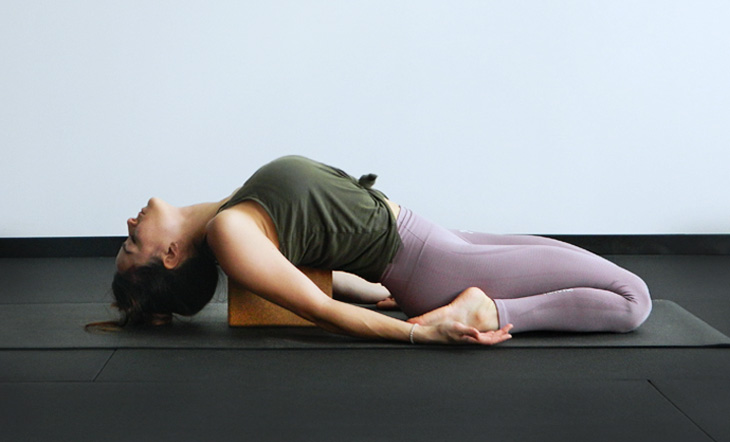




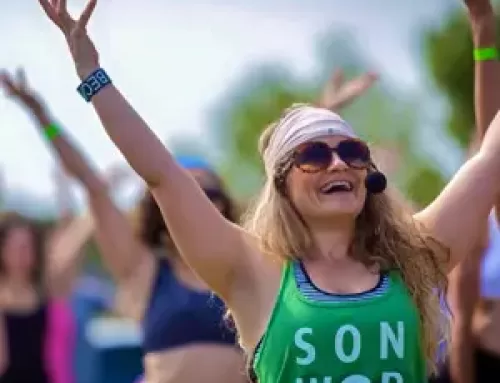
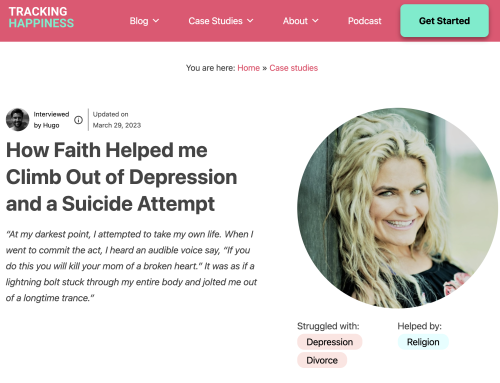

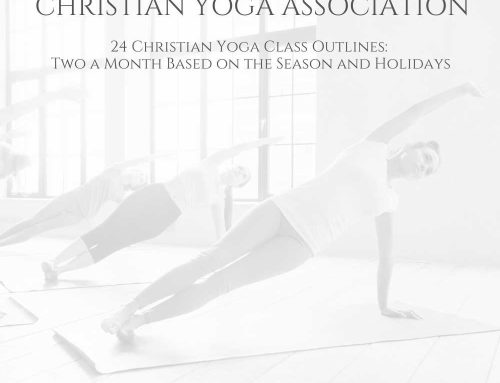
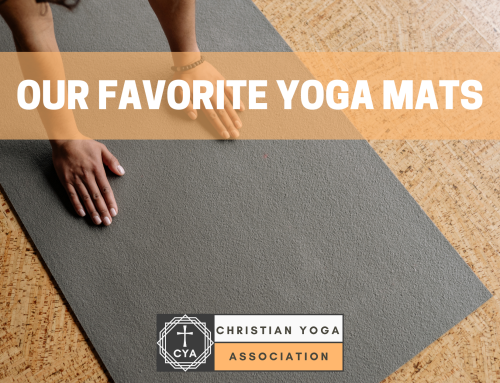
Leave A Comment